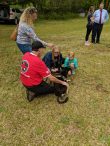
Autism Awareness Month: SCSARDA Training Day
by Rebecca Johnson
As part of Autism Awareness month in April, we were happy to be able to call upon our partners at the South Carolina Search and Rescue Dog Association to conduct a training day with some of our clients. The premise? The clients would be hidden in various areas on the grounds and SCSARDA’s team of highly trained scent dogs would then find them. We have done these mock search and rescue drills with SCSARDA several times before and, in fact. you may have read about one of our previous training days in an earlier blog here on our site. On this particular occasion, we wanted to do more than just provide a fun training day; we also wanted to show you, our community – local and national – just what SCSARDA can do and how these training exercises help both children with autism and the dog and handler teams prepare for these scenarios.
First, let’s introduce our teams!
 |
 |
 |
 |
| Michel and Shadow | Sarah and Bran | Marion and Maya | Mitch and Remington |
So how does search and rescue relate to autism?
Children with autism are shown to be four times more likely to wander off due to sensory stimuli, overstimulation, or due to eloping behaviors when acting out. This can be a stressful time for both parent and child, and when a search team must be called in to help that anxiety can skyrocket. A dog that is unfamiliar with the behavior of a frightened child in emotional distress may become excited, which can increase the child’s anxiety. A child in a heightened state of emotion who has never before interacted with a search and rescue animal may not understand that the dog is there to help. Through regular trainings with SCSARDA, we hope to introduce our population to the search team so that they know and are familiar with the fact that these animals are there to help them and not harm them. For the handlers, it’s a chance for them to teach their dogs how to better react to a child who may already be anxious and overstimulated once found. For you, our reader, we want you to know these resources area available to you should you ever find yourself in a similar situation searching for a lost loved one.
The Training
Watching the dogs at work was an absolute treat. The handlers gave the dogs an item that has been worn or held by the missing individual, or a ‘scent item.’ The best scent items are those worn on the upper body, such as a shirt, jacket or backpack. Once the handler was sure the dog knew the scent from the item, the chase was on!
Several types of scent finding dogs are used in search and rescue. The two most often used are air scenting dogs and trailing dogs. Shadow, Bran and Maya are all air scenting dogs. Remington is a trailing dog.
When air scenting, the dogs are kept off their leashes. They trail back and forth looking for the strongest pooling of the scent. The longer the person has been in an area, the more concentrated the scent in the air will be, allowing the rescue dog to look for the strongest concentration.
Click below to see a clip of Shadow and Michel searching out a target:
Once the dog has found its target, she must come back and inform the handler. In a true search situation, the dog may range quite a bit away from the trainer to follow the scent. The dogs wear bells so they can be heard by their handlers even if they can’t be seen. Each dog and handler will have their own signal that the target has been found. For our teams, the signal was the dog excitedly jumping up at the handler’s chest and then running back towards their target. Once the target individual was found, the dog received a reward of play time, treats or just love and accolades from the handler. Shadow’s preference was a round – or five – of fetch!
When trailing, the dogs stay on leash so the handler can watch their body language better to see if they are ‘on scent.’ The dog may go the wrong way, lose the scent or have to double back. Being able to see that allows the handler to redirect the dog to try and pick up the scent again.
Mitch and his four-legged teammate, Remington, demonstrated this technique for us by searching out a target near the pond:
As with air scenting dogs, the trailing dogs will also signal their trainers when they find their targets and then receive rewards of play, petting or treats. Or, in Remington’s case, a dip in the water!
We were also curious about how the rest of the search party helps. Sarah gave us a run-down of how ‘flankers’ can assist in a true search scenario.
Marion, Maya, and Michel had used a similar technique earlier, with Michel flanking for Marion.
And finally, Sarah and Bran also demonstrated what the dogs do when they find their targets. Scent dogs will check the scent to match it before returning to their handler to tell them the target has been found. They do this by sniffing the target or, as we found out with Bran, licking them.
Overall, everyone had a great afternoon and learned valuable information about search and rescue, including our clients. At the end of the day, lots of smiles were had all around.
We would like to extend our thanks again to SCSARDA for coming out and teaching us all so much about the search and rescue process!
More Coverage of the Event:
Greenville News
Anderson Independent Mail
WSPA-CBS
WHNS-FOX (video)\WHNS-FOX (web article)


